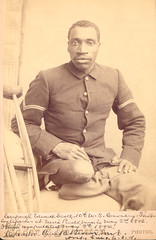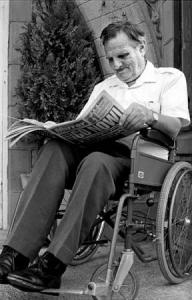Who was first to say or do something? It's not as easy a question to answer as you'd think--historians tend to avoid declaring "the first" unless the situation is extremely clearcut. A simple enough question like (for example) "who was
Canada's first woman doctor?" can have several possible answers, depending mainly on what you mean by
Canadian and
doctor. A few months ago, blogger
Natalie Bennett pointed to
an essay on Comment is Free by David McKie, exploring the hazards journalists face in trumpeting "the first." McKie even used the example of the "first"
disabled Member of Parliament, which is a distinction claimed for several men, but without a single best answer. But,
Blue has set "Firsts" as the theme for the next edition of the
Disability Blog Carnival. So, cautiously, I'll share a first from US disability history. Probably a first. As far as I know....
Mara Buck (1611-c1655?)
and Benoni Buck (1616-39) were the first people with presumed developmental/cognitive/learning disabilities to be described in English documents as being born in America. They were two of the children of Richard Buck (1582-1624), a preacher at the
Jamestown colony in Virginia (celebrating the 400th anniversary of its founding this month). While still back in England, they say
Richard Buck knew William Shakespeare. He was part of an infamous crossing of the Atlantic that was marooned on Bermuda for nine months. He performed the wedding between John Rolfe and Pocahontas. This was no obscure guy. Richard Buck died the same year as his wife, and left a large plantation and minor children, so there were inevitably legal battles within the estate--and it is in those records that we find Benoni described as an "idiot," and Mara as "very dull in taking her lerninge." Benoni Buck lived under the care of guardians, who apparently drew funds from Benoni's inheritance until he died at age 23. Mara Buck eventually married a Mr. Adkins, but her competence to enter into a marriage contract had earlier challenged in court after a suitor attempted to kidnap her from her guardians.
Note that this first record of developmental disability in America isn't a medical record, or an educational record--before cognitive disability was closely explored in those contexts, the legal assessment of incompetence was the most precise and socially consequential. Also note that it often takes a crisis--a crime, a death--to catch any mention of such lives as Benoni Buck's in the net of historical evidence.
Further Reading: Seth Mallios, "Archaeological Excavations at 44JC568, The Reverend Richard Buck Site" (Association for the Preservation of Virginia Antiquities 1999): online
here.
R. Neugebauer, "Exploitation of the Insane in the New World: Benoni Buck, the First Reported Case of Mental Retardation in the American Colonies,"
Archives of General Psychiatry 44(5)(1987): 481-483.
Abstract here.
Irene W. and Frederick Hecht, "Mara and Benomi [sic] Buck: Familial Mental Retardation in Colonial Jamestown,"
Journal of the History of Medicine and Allied Sciences 28(2)(April 1973): 171-176.














